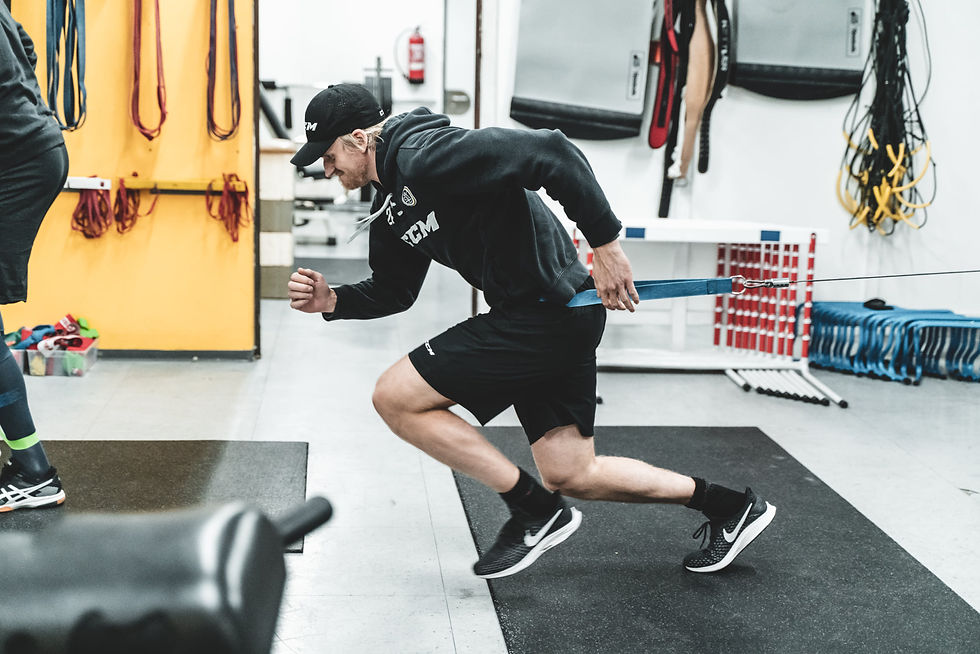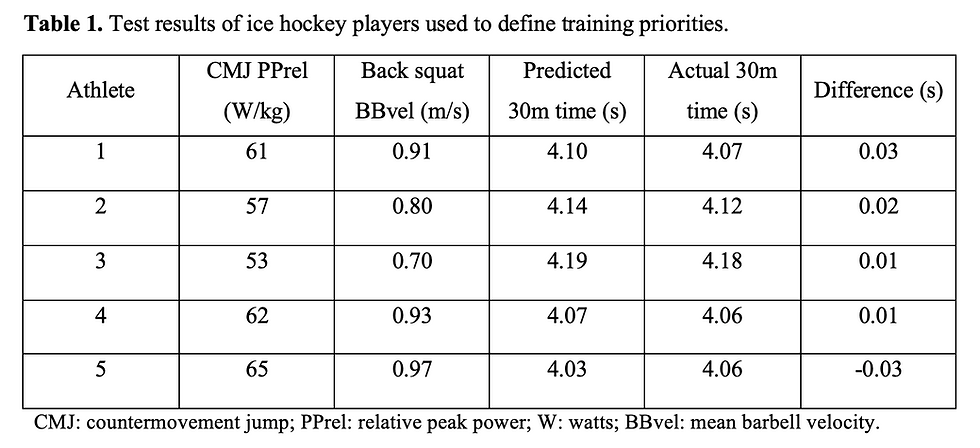Periodisation of training for sports performance commonly evolves from general to specific training, where the dichotomy between general and specific training exercises and methods is represented by the level of similarity of the training exercise to the sporting skill. The principle of specificity states that adaptations to training are specific to the nature of the training stimulus. In order to optimise transfer of training, athletes should therefore perform activities with demands that are similar to performance in their sport. These demands may be defined by mechanical similarity, as proposed by Verkhoshansky and Siff (6) with the criteria of dynamic correspondence which include characteristics such as muscle action and movement velocity, or physiological demands, considering factors such as work duration, intensity, and work-to-rest ratio. Such an approach is exercise-centred, and I would argue that a strength and conditioning (S&C) coach would not optimise his/her programming by implementing it. My goal with this article is to discuss the limitations of this philosophy and to propose an outcome-focussed, adaptation-led approach to programming that would result in an individually optimised transfer to sport performance.
Programming decisions are context-specific and should not be evaluated without a thorough understanding of the constraints and possibilities available to the coach, as well as the desired outcome. However, the scope of an S&C coach is to prepare the athlete for the sport in order to optimise potential for the athlete’s performance. This outcome should help us critically review the limitations of the traditional interpretation of training specificity. I will briefly give three examples that illustrate the limitations of the approach taken by many sports coaches and some S&C coaches. Given my background, I will link these to ice hockey specific training.

“I train on one leg because I run/skate on one leg!” is a common argument for proponents of unilateral training. As a matter of fact, this statement is inaccurate for ice hockey players, given a substantial amount of playing time is spent gliding on both feet and forward skating itself includes both a double- and single-support phase, where players have bilateral support for 80% of the stride duration (5). One could therefore argue that the benefit should be more evident in running-based sports, where unilateral force production is unavoidable. A unilateral training advantage for horizontal speed could not be found in a recent systematic review and meta-analysis by Moran et al. (4). Appleby et al. (1) looked specifically at 20m sprint and 50° change of direction (COD) performance in trained rugby union players comparing the transfer of the back squat and the step-up. Both groups improved their 20m sprint time, but the squat group had a greater improvement in COD performance. This may be explained by the greater eccentric stimulus in the back squat compared to the step-up. Anyhow, it appears clear that a unilateral focus in training does not provide the advantage that is believed based on training specificity.
“Have you ever seen a player with weights on the pitch?” – This comment made in 2018 by Maurizio Sarri, then coach of Chelsea FC, to justify why the strength training sessions of his players did not include lifting weights certainly fuelled discussions in the S&C world. It is also sometimes used by players and coaches who do not enjoy lifting weights or do not understand the value of resistance training. Referring back to the scope of the S&C coach, we are not here to replicate the sport but to increase the athletic potential of the athlete. For example, the criteria of dynamic correspondence consider the principle of overload to improve transfer of strength training. According to these criteria, the hang power clean can be considered specific to ice hockey, if performed with sufficient load, given the improvements in force production and concentric rate of force development that it provides (3).
“That’s what the game looks like!” are words pronounced by coaches who only implement repeated-sprint training for their conditioning, because that is what players do in games. Repeated-sprint training certainly has value and a place. But again, are we trying to replicate the sport or increase the athlete’s potential? A combination of traditional sprint training, sprint interval training (repeated maximal 30-second efforts with a long rest) and longer high intensity interval training has been shown to be more effective to improve repeated-sprint ability in well-trained team-sport athletes (2). It is not what training looks like; it is what it does to you.
So where should we start to implement an outcome-focussed, adaptation-led programming? First of all, this approach places the athlete rather than the sporting skill at the centre of the process. It is therefore fundamental to define the specific outcome priority for the athlete in a given situation and based on a performance model. For this purpose, information should be gathered by confronting performance in the sport (e.g., ice hockey), in an isolated skill of the sport (e.g., 30m skating starts), and in performance testing (e.g., strength and power tests). Testing athletes regularly is therefore fundamental for two reasons: a) to gather sufficient normative data about athletes at different levels of the sport, and b) to determine whether a physical capacity can be excluded as a limiting factor for elite performance. I would suggest that comparison with peers is only secondary and the first level of interpretation should come from the capacity required in the sport itself.

Let us consider the example of a male ice hockey player (forward, Athlete 2 in Table 1) who wants to improve his linear skating speed and for whom we have test results for: a) 30m skating sprint time, b) countermovement jump (CMJ) force plate data, c) mean barbell velocity (BBvel) in a back squat performed with 1.3*body mass (BM). We know that CMJ relative peak power (PPrel) has a nearly perfect correlation (r=.91) with 30m time in forwards and a 1W/kg increase in PPrel corresponds to a 0.01s faster 30m time (unpublished data). We can therefore compare his CMJ PPrel with his 30m time. If, based on the regression equation, his PPrel is lower than his 30m time, the potential for improvement is likely in his lower body force output. If his PPrel is better than his 30m time, the potential for improvement is somewhere else and additional analysis would be required. In this example, his actual 30m time is 0.02s better than his predicted time, which indicates a good skating technique. An improvement is therefore required off-ice. Jump power is correlated to maximal strength, which is itself correlated to barbell velocity at submaximal loads. His 1.3*BM squat BBvel is 0.8m/s. Given a PPrel of over 60W/kg is required to be a fast skater (Table 1) and players with a 60W/kg PPrel typically squat at 0.90-0.95m/s, his potential of improvement is in lower body force production. This analysis allows us to determine his potential for improvement and consequently define the programming priority for him. This priority is performance-driven, outcome-focussed and individual-specific. His training programme should now be designed based on the desired adaptations that will enable a better performance.

We have considered the change that we are looking for. As Alex Wolf (7), the former head of S&C for the English Institute of Sport, has described, this change can happen through adaptations at three levels: at structural level, in local coordination, and in global coordination. The structural level refers to the muscle/tendon structure. Local coordination refers to muscle/tendon coordination and it is internally specific to the task. Global coordination refers to the anatomical sling interaction, which means the coordination of the body in the context of the skill itself. For our example, the following structural adaptations may therefore be targeted for greater lower body force production: greater cross-sectional area, increase in type II fibres, and increase in fascicle length. The most effective methods to obtain these adaptations, including heavy lifting and eccentric training, may not be considered specific with a traditional approach, however they should now appear specific to the targeted outcome of our example. A similar thought process can be applied at the local coordination level. Wolf describes this process as “intention-led”. Given the importance of force production by hip and knee extensors in skating starts, an explosive low box step-up with submaximal load could provide the required specificity for change at the local coordination level. When applied to the skill itself, these structural and coordinative changes will provide the athlete with the potential for a new movement solution and a better performance in the sporting skill. In the example provided above, specific changes were targeted with a performance-driven, outcome-focussed, adaptation-led, individual-specific approach to programming. The goal was not to replicate a sporting skill or to become stronger in a specific lift, but to provide the athlete with new athletic potential of sports performance, based on the scope of an S&C coach. With this article I hope to have encouraged a critical reflection by coaches and that training specificity may in the future be considered through the lens of an adaptation-led approach to programming. References
1. Appleby, B. B., Cormack, S. J., & Newton, R. U. (2020). Unilateral and bilateral lower-body resistance training does not transfer equally to sprint and change of direction performance. Journal of Strength and Conditioning Research,34(1), 54–64.
2. Laakso, L. A. (2020). Critical evaluation of the physiological adaptations to repeated-sprint training: Implications for training recommendations and repeated-sprint ability of well-trained field-based team-sport athletes. Journal of Australian Strength and Conditioning, 28(4), 75–81.
3. Laakso, L. A., & Schuster, J. G. (2020). Dynamic correspondence of the hang power clean to skating starts in men’s ice hockey. Strength and Conditioning Journal. Advance online publication. https://doi.org/10.1519/SSC.0000000000000618
4. Moran, J., Ramirez-Campillo, R., Liew, B., Chaabene, H., Behm, D. G., García-Hermoso, A., Izquierdo, M., & Granacher, U. (2021). Effects of bilateral and unilateral resistance training on horizontally orientated movement performance: A systematic review and meta-analysis. Sports Medicine, 51(2), 225–242.
5. Pearsall, D. J., Turcotte, R. A., & Murphy, S. D. (2000). Biomechanics of ice hockey. In W. E. Garrett Jr. & D. T. Kirkendall (Eds.). Exercise and Sport Science (pp. 675–692). Lippincott Williams & Wilkins.
6. Verkhoshansky, Y., & Siff, M. C. (2009). Supertraining (Sixth Edition Expanded Version). Verkhoshansky.
7. Wolf, A. (2020). Strength and conditioning for rowing. The Crowood Press Ltd.

Comments